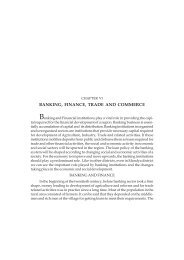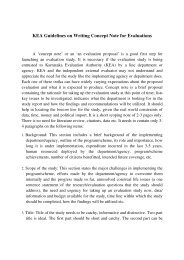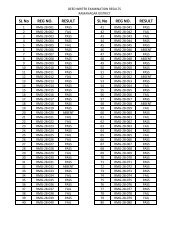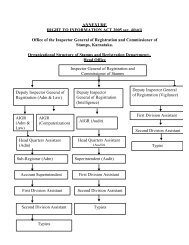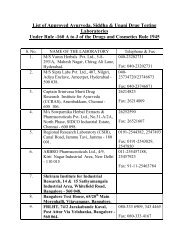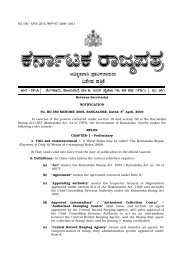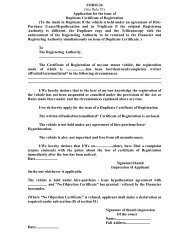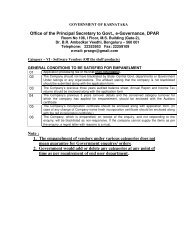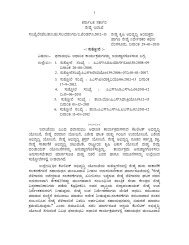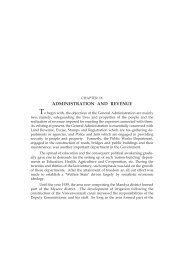Chapter XIII CULTURE - Government of Karnataka
Chapter XIII CULTURE - Government of Karnataka
Chapter XIII CULTURE - Government of Karnataka
You also want an ePaper? Increase the reach of your titles
YUMPU automatically turns print PDFs into web optimized ePapers that Google loves.
Culture 497<br />
The city <strong>of</strong> Mysore was the centre <strong>of</strong> all literary and political activities in the<br />
erstwhile Mysore State and naturally, newspapers and periodicals were born<br />
there. ‘Mysore Vruttanta Bodhini’, and ‘<strong>Karnataka</strong> Prakashika’ were among<br />
them. Newspapers and periodicals were published from Belgaum, Bijapur,<br />
Dharwad, Mysore, Shimoga, Karwar and Bangalore also during the same<br />
period.<br />
M.Venkatakrishnaiah, the grand old man <strong>of</strong> Mysore, excelled in journalism.<br />
He ventured into journalism through the ‘Hita Bodhini’, a journal <strong>of</strong> high<br />
esteem in 1883. It was edited by M.B. Srinivasa lyengar and M.S. Puttanna.<br />
Venkatakrishnaiah started his own weekly, the ‘Vruttanta Chintamani’ in<br />
1885. Readers were thrilled to read his sharp editorial comments. He started<br />
many journals both in Kannada and English in Mysore. ‘Mysore Herald’ (1886,<br />
English), ‘Wealth <strong>of</strong> Mysore’ (1912, English Monthly), the ‘Sampadabhyudaya’<br />
(Kannada daily, 1912) the ‘Nature Cure’ (English), and the ‘Sadhvi (1912).<br />
The ‘Sadhut, which started as a Kannada weekly was being run as a daily<br />
till recently. As a man with reformist ideas, Venkatakrishnaiah has left his<br />
incredible marking on Kannada journalism.<br />
In the beginning <strong>of</strong> the Twentieth Century political movements changed the<br />
surface <strong>of</strong> Kannada journalism. The Indian National Congress and the entry <strong>of</strong><br />
Mahatma Gandhi on the political scene <strong>of</strong> India did have their impact on this<br />
field. For many young enthusiasts, newspapers became the potent medium<br />
to preach, the idea <strong>of</strong> national freedom. The ‘Kannada Kesari’ (Hubli), the<br />
‘Chandrodaya’(1913), Dharwad, Kerur Vasudevacharya’s ‘Shubhodaya’ (1917)<br />
Dharwad and the ‘Sachitra Bharata’ (1913), the ‘Karmaveera’ (1921, Dharwad),<br />
the ‘Kannadiga’ (1925, Bagalkot) and the ‘Vijaya’ (1921, Dharwad) extended<br />
their maximum support to the nationalist movement. D.V. Gundappa, a<br />
noted Kannada author, was also a journalist par excellence. His journalistic<br />
ventures include the ‘Bharati’ (1907, Bangalore) a Kannada Daily, a bi-weekly<br />
the ‘Mysore Times’ (1909, Bangalore), the ‘Artha Sadhaka Patrika’ (1915) a<br />
Kannada monthly, and the ‘<strong>Karnataka</strong>’ (1912, Bangalore) a bi-weekly in<br />
English. ‘Vibhakara’ (1917-18, Belgaum) a Kannada-English weekly started<br />
by Panditappa Chikkodi who spearheaded the movement for the backward<br />
classes. ‘Mysore Star’ from Mysore started by the close <strong>of</strong> the 19th century did<br />
similar work.<br />
P.R. Ramaiah’s ‘Tayi Nadu’ (1926, Mysore) was a staunch nationalist<br />
newspaper. In the beginning, it was a weekly originating from Mysore, but later<br />
was transferred to Bangalore and converted into a daily (1928). N.S.Seetharama<br />
Sastry worked in both the weekly and daily ‘Desha Bandhu’ (1931, Bangalore)<br />
edited by C.Hayavadana Rao. He was succeeded by N.S. Venkoba Rao. The<br />
‘Veera Kesari’ (1928, Bangalore) <strong>of</strong> M. Seetharama Sastry made its presence<br />
felt, by his sharp editorials. T.T.Sharman who had a penchant for the hecking<br />
<strong>of</strong> authorities, endeared himself to the freedom lovers. The writings in his<br />
‘Vishwa <strong>Karnataka</strong>’ (1925) always troubled the authorities. Siddavanahalli<br />
Krishna Sharma ran the paper when T.T. Sharma was unable to attend to<br />
his work for some time. B.N. Gupta’s ‘Prajamata’ (1931, Madras) was an<br />
eye-sore to the authorities constantly. When it was shifted to Bangalore it



